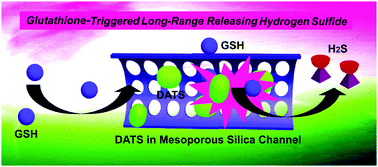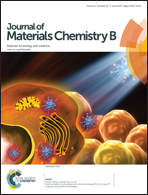Mesoporous silica nanoparticles for glutathione-triggered long-range and stable release of hydrogen sulfide†
Abstract
Mesoporous silica nanoparticles (MSNs) that can stably load therapeutic drugs and release them in response to a specific trigger are of great interest in disease diagnosis and treatment. However, the controlled-release of gaseous drug molecules such as hydrogen sulfide (H2S) from a long-range and stable MSN-based system still presents a great challenge. Herein, a MSN-based glutathione (GSH)-triggered controlled-release H2S system has been fabricated with high entrapment efficiency (99.0 ± 0.3%) and loading content (44.2 ± 0.1%) of diallyl trisulfide (DATS). After the addition of GSH (2 mM), DATS-MSN (100 μg mL−1) steadily releases moderate amounts of H2S (peaking at the 4th hour, ∼60 μM) in phosphate buffer solution (PBS). The release of H2S in plasma is similar to a physiological process (peaking at the 4th hour) and the DATS-MSN remains in the plasma of a rat's system over 9 hours without significantly affecting the blood pressure, heart rate and cardiac function. Moderate quantities of nanoparticles can be taken up by cardiomyocytes in vitro, while in vivo study shows that nanoparticles mainly accumulate in the liver and spleen, affecting the H2S level in these organs. Furthermore, DATS-MSN shows excellent biocompatibility, as well as superior cytoprotection and an isolated heart protection effect of H2S under ischemic/reperfusion injury. This study provides a new insight into controlled-release applications of MSN-based H2S releasing systems both in vitro and in vivo.



 Please wait while we load your content...
Please wait while we load your content...